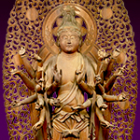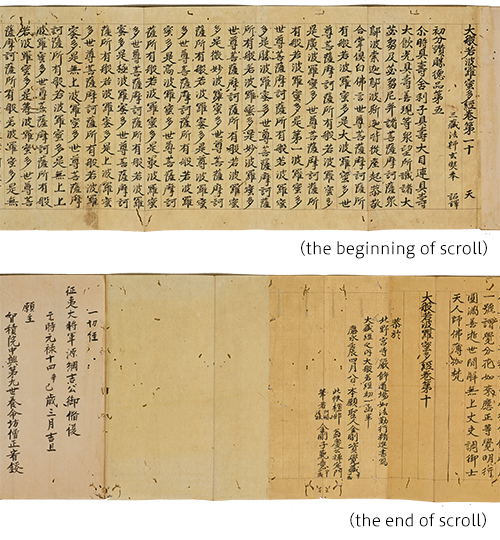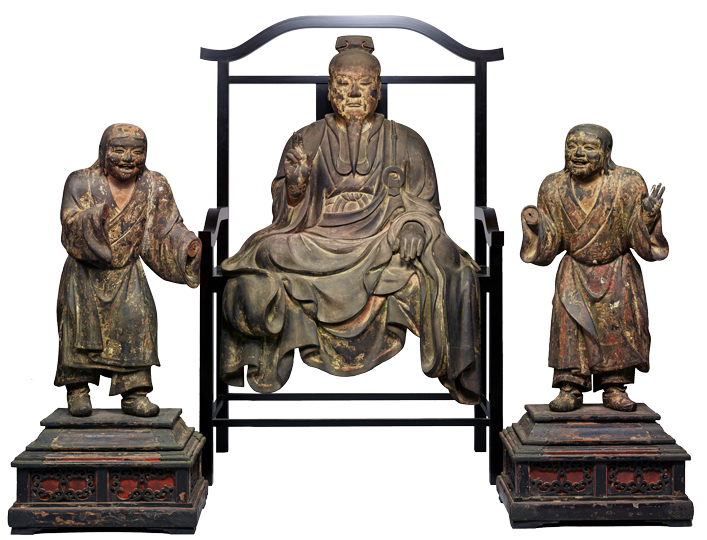Highlights of the Exhibition
The History and Treasures of Daiho’onji —Daiho’onji Temple and Kitano Kyo’odo Hall
Creation of a Sacred Place —The Flourishing of Belief in Sakyamuni Buddha
Roku Kannon Bosatsu (Six manifestations of Avalokitesvara) and Higo Jokei
The History and Treasures of Daiho’onji —Daiho’onji Temple and Kitano Kyo’odo Hall
Daiho’onji temple was located immediately to the northwest of the greater palace of the Heian Palace. Within reach of this, on the west side of present-day Kitano Tenmangu shrine, there is said to have been an ancient temple whose founding dated back to the 7th century. This temple was later established as a temple connected to Emperor Kanmu after the relocation of the Japanese capital to Kyoto in 794. From historical events such as these, it is known that this area was being developed from ancient times. Although its provenance is uncertain, the statue Standing Senju Kannon Bosatsu (Sahasrabhuja), which dates back to the early Heian period (794–1192), has been preserved at Daiho’onji.
Daiho’onji houses many other surviving treasures associated with Kitano Kyo’odo Hall, which is no longer extant. The hall was originally a Buddhist temple built by Ashikaga Yoshimitsu, the third shogun of the Muromachi shogunate, and was a place where the Muromachi shogunate family practiced their deep religious belief. The Complete Buddhist scriptures from Kitano Kyo’odo hall, which exceeds 5,000 volumes, and the statues Seated Fu Daishi (Buddhist Master Fu Xi) and standing two child attendants, are objects associated with a rotating repository for sutras. Managed by the Kyo’odo Hall, this repository was located in the grounds of Kitano shrine. Through the numerous treasures preserved at Daiho’onji such as these, the temple reveals the layered history of this area.
This part unveils the history of Daiho’onji as well as of Kitano Kyo’odo Hall, a construction whose management Daiho’onji was closely involved with.
Page Top
Creation of a Sacred Place —The Flourishing of Belief in Sakyamuni Buddha
In the first half of the 13th century, when Daiho’onji temple was founded, people strongly felt that they were living in an age of the degeneration of Buddhist Law. This is a time, it is said, when the Buddha’s teachings lose their power to lead people to enlightenment, and practitioners of Buddhism disappear. From the end of the 12th century, a number of events seemed to herald this ruin of Buddhism and the decline of imperial authority linked to it. These events were a civil war that raged across Japan between the Minamoto and Taira clans (1180–1185), a succession of large-scale disasters, and, above all, the wartime destruction of the Great Buddha statue at Todaiji temple (1180). Against this historical background, a movement for returning to the teachings of the founder of Buddhism, Sakyamuni Buddha, gathered momentum and a belief in Sakyamuni Buddha flourished.
Giku (1172–1241), a Buddhist monk of the Tendai school, founded Daiho’onji based on the teachings of the Hoke kyo (Lotus sutra), which states that Sakyamuni Buddha exists in this world eternally to preach the Buddhist truth. The statues, Ten major disciples of Buddha by Kaikei and Seated Shaka Nyorai (Sakyamuni Buddha) by Gyokai, a student of Kaikei, are still preserved at this temple. When the wooden framework of the temple’s Main Hall was originally completed, statues of Monju Bosatsu (Manjusri) and Miroku Bosatsu (Maitreya) were also enshrined at the temple. The composition of this grouping of Buddhist deity statues is thought to signify Sakyamuni Buddha preaching on Vulture Peak, an event described in the preface to the Lotus sutra.
By establishing this representation of Sakyamuni Buddha to reside eternally and preach in this world, Giku had created a place to save people living in an age of the degeneration of Buddhist Law.
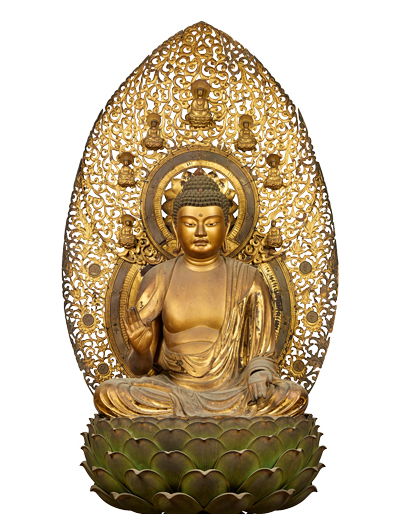  |
Seated Shaka Nyorai (Sakyamuni Buddha)
By Gyokai, Kamakura period, 13th century, Daiho’onji, Kyoto
(Important Cultural Property)
|
 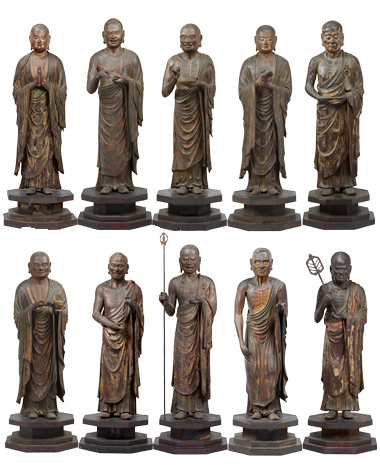
Ten major disciples of Buddha
by Kaikei, Kamakura period, 13th century, Daiho’onji, Kyoto (Important Cultural Property)
From left to right, Standing Ananda, Standing Ragora (Rahula), Standing Upari (Upali), Standing Anaritsu (Aniruddha), Standing Kasen'en (Katyayana), Standing Furuna (Purna), Standing Subodai (Subhuti), Standing Daikasho (Mahakashyapa), Standing Mokukenren (Maudgalyayana), Standing Sharihotsu (Shariputra) From upper left to lowe right, Standing Ananda, Standing Ragora (Rahula), Standing Upari (Upali), Standing Anaritsu (Aniruddha), Standing Kasen'en (Katyayana), Standing Furuna (Purna), Standing Subodai (Subhuti), Standing Daikasho (Mahakashyapa), Standing Mokukenren (Maudgalyayana), Standing Sharihotsu (Shariputra)
|
Page Top
Roku Kannon Bosatsu (Six manifestations of Avalokitesvara) and Higo Jokei
Daiho’onji temple preserves the statues Roku Kannon Bosatsu (Six manifestations of Avalokitesvara) created by Jokei, who was a Buddhist sculptor of the Keiha school and a student of Unkei. The six manifestations of Avalokitesvara are a collective term for Arya Avalokitesvara, Sahasrabhuja, Hayagriva, Ekadasamukha, Cundi (or Amoghapasa), and Cintamanicakra Avalokitesvara. As manifestations of Buddha saving people from the six realms of beings, including the realm of hell and the realm of hungry ghosts, they became highly prevalent in Japan from the Heian period (794–1192) onward. This set of six statues dates back to Japan’s mediaeval era and is the only example of its kind with all of the original halos and pedestals intact.
According to an ink inscription left inside the statue of Cundi, these statues were created by Jokei in 1224 (Jo’o 3). Jokei was around ten years younger than Tankei, the eldest son of Unkei, and was a talented Buddhist sculptor of the post-Unkei generation. Jokei carefully studied the style of Unkei and had a considerable skill for perfecting the physical shapes of Buddhist statues. The details of his statues also reveal his amazing carving techniques, which are reflected in his depictions of the soft texture of the hair tied up, the intricate movements of the bunched hair ends, the robes puffed up with air, and the garments flattering in the wind.
The vivid sense of presence exuded by these statues was perhaps something that people at the time, living in an age of the degeneration of Buddhist Law, were fervently seeking from the Buddha.
 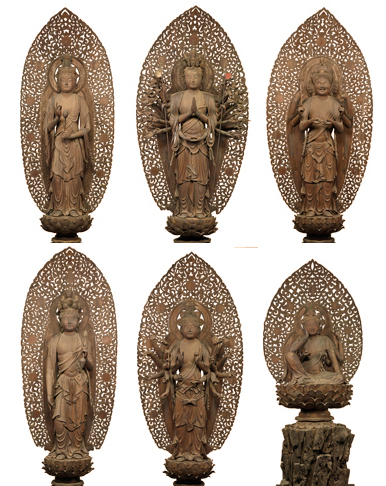
Roku Kannon Bosatsu (Six manifestations of Avalokitesvara)
By Higo Jokei, Kamakura period, dated 1224, Daiho'onji, Kyoto (Important Cultural Property)
From left to right, Standing Sho Kannon Bosatsu (Arya Avalokitesvara), Standing Senju Kannon Bosatsu (Sahasrabhuja), Standing Bato Kannon Bosatsu (Hayagriva), Standing Juichimen Kannon Bosatsu (Ekadasamukha), Standing Jundei Kannon Bosatsu (Cundi), Seated Nyoirin Kannon Bosatsu (Cintamanicakra Avalokitesvara)
From upper left to lower right, Standing Sho Kannon Bosatsu (Arya Avalokitesvara), Standing Senju Kannon Bosatsu (Sahasrabhuja), Standing Bato Kannon Bosatsu (Hayagriva), Standing Juichimen Kannon Bosatsu (Ekadasamukha), Standing Juntei Kannon Bosatsu (Cundi), Seated Nyoirin Kannon Bosatsu (Cintamanicakra Avalokitesvara)
|
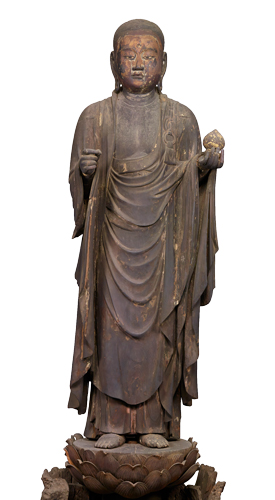  |
Standing Jizo Bosatsu (Ksitigarbha)
Kamakura period, 13th century, Daiho’onji, Kyoto
|
Page Top
![]() PDF (
PDF (![]() 653KB)
653KB)
